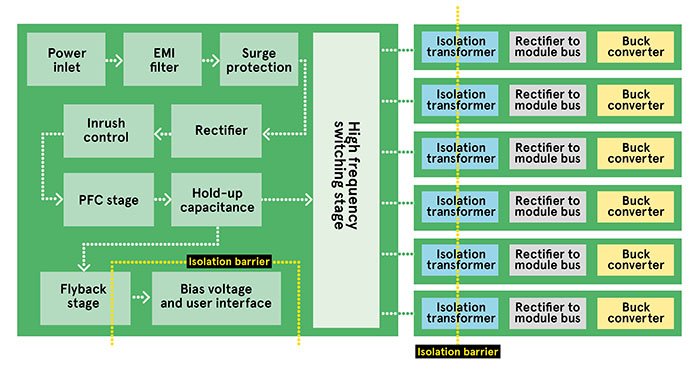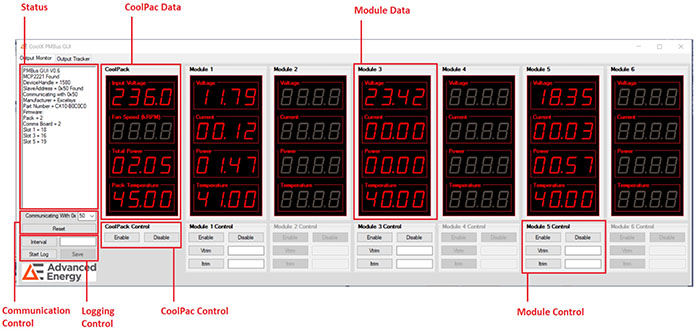Designing with modular, configurable power supplies
‘Modular power supplies’ mean different things depending on the market but in this article, we will be discussing AC/DC converters that typically comprise a chassis ‘front end’ with EMI filtering, surge protection, a power factor correction stage, auxiliary functions and bulk energy storage. Jon Cooper, Technical Manager, UK & Ireland, Avnet Abacus, explains.
This is followed by ‘modules’ – pluggable cards which can be selected from a range available to provide a particular output or combination of regulated outputs. The modules incorporate safety isolation from the AC input and between outputs and can be connected by the user in series or parallel for a wide variety of output specifications. Figure 1 shows a typical arrangement.

Figure 1: A typical modular power supply block schematic
Advantages and applications
It’s obvious from Figure 1 that there is a degree of duplication in the output modules and the feature to make them pluggable adds to mechanical complexity, but what this also means is that ultimate flexibility is built in. Where unusual combinations of outputs are needed, a custom design is avoided. Also, as specifications change during development or when the unit is part of a platform system design with different field options, outputs can be reconfigured at will. The modular system holds safety agency certification which is maintained after reconfiguration, with just a paperwork update of the actual modules used. Industrial and medical safety standards are typically supported and EMI characteristics are also predictable for all configurations.
An alternative that might be considered to achieve a non-standard range of outputs is to use multiple, single output AC/DCs. This has the disadvantages however of additive mains leakage currents that may exceed the regulatory limit, particularly in medical applications. There is also the problem of additional, more unpredictable EMI from unsynchronised converters and the cost and bulk of additional connectors and cabling. Installation costs are higher and the flexibility of a modular solution is lost, along with features such as output sequencing and paralleling. Similarly, if additional outputs are generated from DC/DC converters ‘cascaded’ from a single AC/DC output, flexibility and control functionality are lost along with an inevitable degradation of system efficiency.
The modular approach enables a very quick, flexible off-the-shelf solution with no minimum order quantity, so in typical tight product development schedules, power supply procurement can be off the ‘critical path’. As an additional benefit, system designers can take advantage of the modular approach which inherently gives comprehensive control and monitoring of each output, reducing need for external circuitry. It can be seen that a modular power supply approaches the functionality of a high-end programmable bench-top supply, but without the cost premium.
Features available
Output voltage on each module can typically be separately adjusted by potentiometer, analogue input or digitally over an I2C bus using PMBus commands. Current can also be sensed, controlled and accurately limited making the modular power supply suitable for a wide range of applications with external feedback from sensors controlling output characteristics. Battery charging would be an example with a programmed profile of charge current and voltage for optimum performance with battery cell temperature variations. Output sequencing is also available by connecting one module ‘power good’ output to other module ‘enable’ inputs. Because the modules are free-standing functional blocks, several can be combined, each with its own profile. For example, a complex battery charge profile from one module and a constant voltage from another, for system control functions.
Series and parallel connection considerations
Modules are designed for easy parallel and series connection, for increased current and voltage respectively. This gives useful flexibility for power upgrades, within the total rating of the front end, or generation of higher voltages, settable over a wide range by the individual module controls. In parallel, module outputs are strapped together and current sharing is achieved by one of different techniques. As paralleled modules have a common return, analogue control signals can be directly interconnected. In series connection, the returns are at different potentials so interconnected control signals such as voltage trim will need isolation through linear optocouplers or equivalent. ‘Digital’ signals and control lines such as ‘power good’ and ‘enable’ might have optocoupler isolation already included in the module but with isolated PMBus capability all control is independent of the series or parallel connection.
When connecting module outputs in series, attention should be paid to the effect on safety certification. If the combined output voltage exceeds 60V, it is deemed hazardous by the safety standards and requires a barrier between the output and any surface accessible to touch. The relevant standard can be consulted for the creepage, clearance or solid insulation requirements. Each module has an isolation rating from outputs to chassis earth, which might be as low as a few hundred volts, this means series connection should not be allowed to exceed this.
Series connection can also be used to generate a bi-polar output, say +/- 12V with the centre point grounded. In this case, problems can occur if current can flow from either output to ground in the load as well as from positive to negative. Under start-up conditions, it is possible for one module output to be transiently reverse biased preventing correct operation. For this reason it is advisable to add anti-parallel diodes across each output, ideally low drop types.
Advanced functionality
We have already mentioned the flexibility that PMBusconnectivity can bring with individual control of modules to suit any static or dynamic output voltage and current profile. Monitoring signals used can also be made available via the bus for external data analytics. For example, changes over time can be monitored to identify the state of health of the power supply and the system load. Obvious indications such as high temperature may indicate fan failure; or clogged filters or a fan speed signal can indicate cooling issues generally. Increasing or decreasing average load current over time can indicate degrading load circuitry, and of course total failure of an element of a redundant power supply system can be signalled. The functionality provided therefore allows preventative maintenance and better system availability. Typically, manufacturers provide a GUI as an easy way to monitor and control the front end and modules (Figure 2).

Figure 2: A snapshot of the GUI for a modular power supply – Source: Advanced Energy
All control and signalling can be achieved over the PMBus, but companies such as Advanced Energy are developing wireless interfaces that make it simpler still. Without the need for the physical I2C bus connection to a central controller, the data can be read wirelessly, perhaps by a technician by Bluetooth with a mobile app. Alternatively it could be wirelessly consolidated via the cloud to a central database at the supplier, to provide a real-time monitoring service and collection of historical data and its trends. In the other direction, with real time remote connectivity, a supplier can collect performance data to inform future designs and even re-program functionality ‘on the fly’ for better system performance. A scenario could be imagined where it is identified remotely that two outputs are paralleled but never loaded beyond the rating of one module, resulting in both running inefficiently at light load. Disabling one module could then improve system efficiency.
Conclusion
A power supply design that meets user specifications exactly without the modular functionality might seem a lower cost option, but only if it is a standard product already made in volume. If the specification is non-standard and commissioned as a custom, there is substantial technical and time risk incurred and the costs of development, qualification and agency certification are uncertain and require typically tens of thousands of product sales to pay back. If the specification changes during product development or after launch, potentially these costs recur.
If flexibility, speed to market, low risk, and a pre-certified power supply are important, then a modular approach can be the right choice. Advanced Energy are leaders in the supply of modular power supplies with power ratings up to 3kW and with up to 24 outputs. Through their distributor Avnet Abacus, they can advise on the best modular power supply solution for you.










